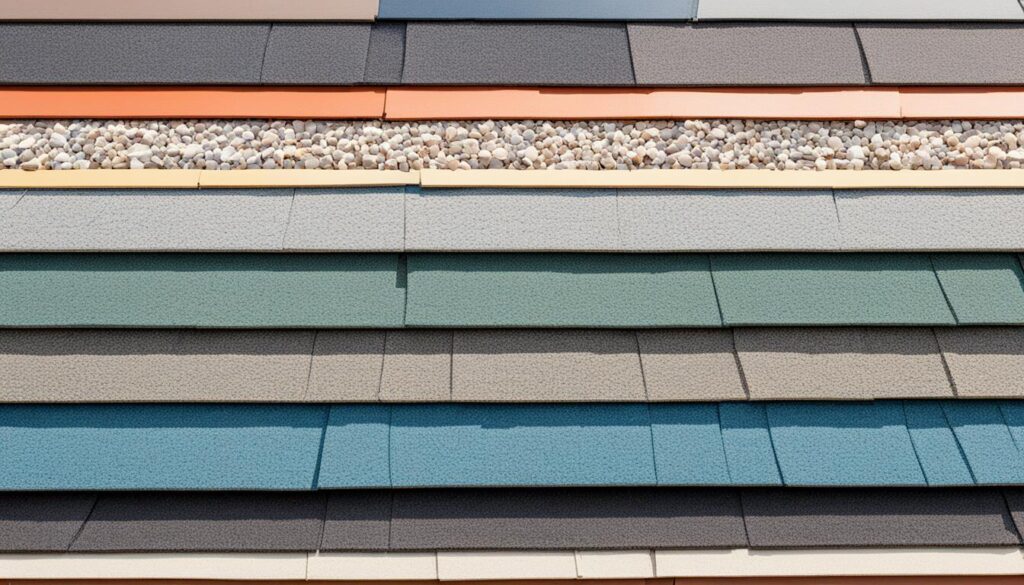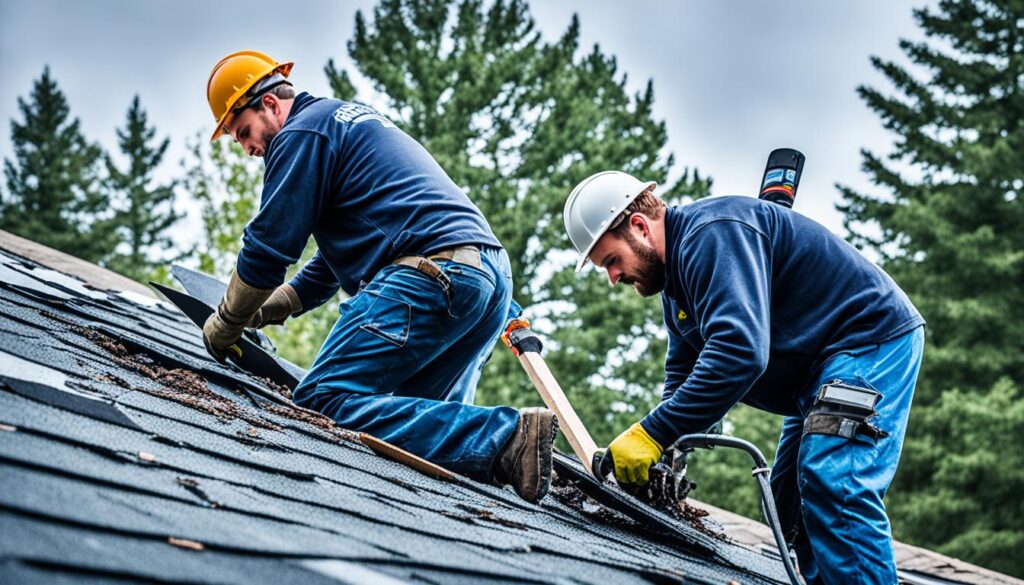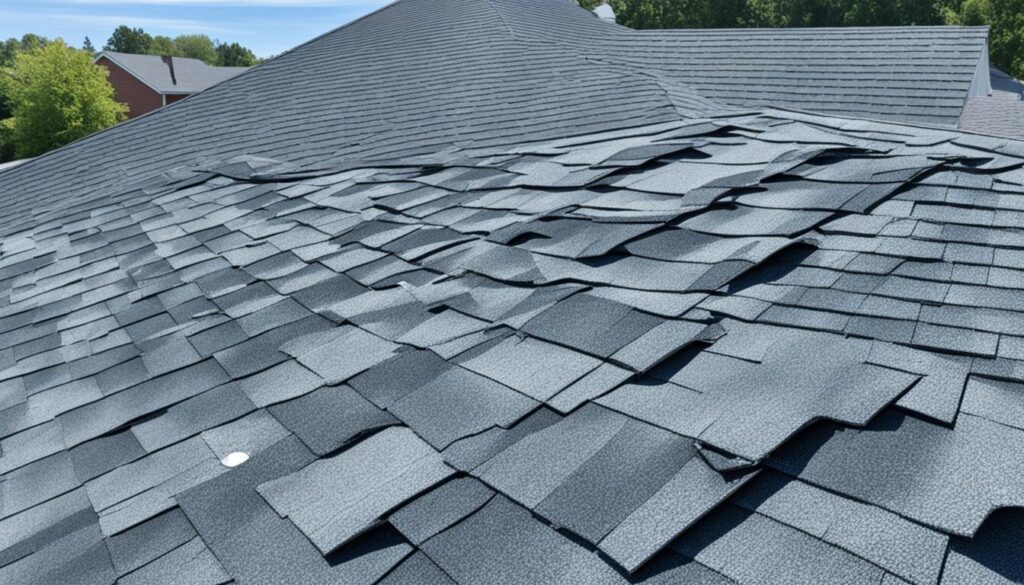When it comes to the lifespan of a roof, many factors come into play. One of the common questions homeowners ask is, “How long does a roof last?” Unfortunately, there is no one-size-fits-all answer. The average lifespan of a roof can vary depending on various factors, including the type of materials used, the quality of installation, and regular maintenance. Let’s explore the factors that determine a roof’s durability and lifespan.
Key Takeaways:
- The lifespan of a roof depends on multiple factors.
- Factors such as materials, installation quality, and regular maintenance contribute to a roof’s durability.
- Different roofing materials have different lifespans.
- Regular inspections and maintenance can help extend the life of a roof.
- Eventually, a worn-out roof will need to be replaced.
Understanding how long a roof lasts and what factors impact its durability can help homeowners make informed decisions. In the following sections, we will delve deeper into the key factors that can affect the lifespan of a roof, the different types of roofs and their typical lifespans, how to extend the lifespan of a roof through proper maintenance, and what to consider when replacing a worn-out roof.
Factors that Impact the Lifespan of Your Roof
The lifespan of your roof is influenced by several key factors that should be considered when choosing roofing materials and maintaining your roof for maximum durability. These factors include:
- Type of Materials: Different roofing materials have varying degrees of durability and longevity. Factors such as resistance to UV rays, weather conditions, and wear and tear can affect the lifespan of the roof.
- Quality of Materials: The quality of the roofing materials used plays a crucial role in determining how long the roof will last. High-quality materials are likely to withstand the elements better and have a longer lifespan.
- Underlayment: The underlayment beneath the roofing materials provides an additional layer of protection and can contribute to the longevity of the roof.
- Workmanship of Installation: Proper installation techniques and attention to detail are essential for ensuring the longevity of a roof. Poor workmanship can result in premature roof failure.
- Elements: Climate, sun exposure, temperature fluctuations, storms, and trees can all impact the lifespan of a roof. For example, roofs in regions with extreme temperatures or frequent severe weather may experience more wear and tear.
- Color of Materials: The color of roofing materials can affect their durability. Dark-colored roofs tend to absorb more heat, which can lead to faster deterioration.
- Slope of the Roof: The slope or pitch of the roof can impact its lifespan. Roofs with steeper slopes tend to shed water more effectively, reducing the risk of leaks and water damage.
- Ventilation: Proper ventilation helps regulate the temperature and moisture levels in the attic, extending the lifespan of the roof by preventing the accumulation of excess heat and moisture.
- Regular Roof Maintenance: Regular inspections, repairs, and maintenance are crucial for identifying and addressing potential issues before they cause significant damage to the roof.
Each of these factors should be carefully considered when selecting roofing materials and maintaining your roof to ensure it reaches its maximum potential lifespan.
By evaluating these factors and taking the necessary precautions, you can extend the lifespan of your roof and protect your investment for years to come.
Lifespan Comparison of Different Roofing Materials
| Roofing Material | Average Lifespan |
|---|---|
| Three-Tab Asphalt Shingles | 15 to 20 years |
| Wood Shingles | Up to 30 years |
| Metal Roofs | 20 to 50 years or more |
| Architectural Asphalt Shingles | 30 to 50 years |
| Composite Shingles | 40 to over 50 years |
| Slate Tiles | Well over 50 years, up to 100 years |
| Concrete or Clay Tiles | 50 years or more |
Comparing the lifespans of different roofing materials can help you make an informed decision when choosing the right option for your home.
Types of Roofs and Their Lifespans
Different types of roofs have different lifespans. It’s important to choose the right roof material based on the desired lifespan and the specific needs of the property. Here’s a breakdown of the lifespans of various roofing materials:
| Roofing Material | Lifespan |
|---|---|
| Three-Tab Asphalt Shingles | 15 to 20 years |
| Wood Shingles | Up to 30 years |
| Metal Roofs | 20 to 50 years (depending on thickness) |
| Architectural Asphalt Shingles | 30 or 50 years |
| Composite Shingles | 40 to over 50 years |
| Slate Tiles | Well over 50 years and sometimes up to 100 years |
| Concrete or Clay Tiles | 50 years or more |
| Commercial Roofs (EPDM, PVC, TPO, Spray Foam) | Lifespan ranges vary |
As you can see, the choice of roof material can significantly impact the lifespan of your roof. Consider the durability, maintenance requirements, and climate suitability when making your decision. It’s also important to note that regular roof maintenance and inspections can help maximize the lifespan of any roof material.
Remember, a well-maintained roof can protect your property for many years to come.

Extending the Lifespan of Your Roof
Ensuring the longevity of your roof requires regular maintenance and proactive measures. By following these roof maintenance tips, you can extend the lifespan of your roof and avoid costly repairs or premature replacements.
- Schedule Annual Inspections: Arrange for professional roof inspections at least once a year. These assessments will help identify any potential issues before they escalate into major problems.
- Address Warning Signs Promptly: If during an inspection or regular maintenance, you notice cracked or curled shingles, damaged flashing, leaks, or any other signs of roof damage, don’t delay repairs. Timely attention can prevent further deterioration.
- Maintain Proper Ventilation: Adequate ventilation is crucial for maintaining a consistent temperature in your attic and preventing moisture buildup. Good ventilation helps prevent issues such as cracking, freezing, and overheating, which can shorten your roof’s lifespan.
- Keep the Roof Clean: Regularly remove debris such as leaves, branches, and dirt from your roof. This debris can hold moisture and contribute to the growth of moss or algae, which can damage your roof over time. A clean roof will have a longer lifespan.
- Choose a Reputable Contractor: When it comes to roof repairs, replacements, or maintenance, always work with a professional and reputable contractor. Their expertise and quality workmanship can ensure that your roof is installed and maintained correctly, maximizing its lifespan.
- Opt for High-Quality Materials: Investing in high-quality roofing materials may initially cost more, but it can significantly extend the lifespan of your roof. Durable materials are more resistant to wear and damage caused by weather conditions, reducing the need for frequent repairs or replacements.
- Consider Color and Slope: The color of your roof can impact its lifespan. Light-colored roofs reflect more sunlight, reducing heat absorption and minimizing temperature fluctuations. Additionally, roofs with proper slopes help water drain efficiently, preventing ponding and potential water damage.
By following these roof maintenance tips and taking proactive measures, you can enhance the longevity of your roof, saving you both time and money in the long run.
“Regular maintenance and proactive measures can extend the lifespan of your roof, saving you both time and money in the long run.”
Bonus Tip: The Importance of Gutter Maintenance
While conducting regular roof maintenance, don’t forget to pay attention to your gutters. Clogged or damaged gutters can lead to water accumulation on your roof, causing potential leaks and damage. Make sure to clean and inspect your gutters regularly to maintain optimal roof drainage.
| Roof Maintenance Tips | Benefits |
|---|---|
| Regular inspections | Identify and address issues early |
| Prompt repairs | Prevent further damage |
| Proper ventilation | Maintain consistent temperature |
| Clean roof | Prevent moisture buildup |
| Work with reputable contractor | Ensure quality installation and maintenance |
| Use high-quality materials | Enhance durability and resistance |
| Consider roof color and slope | Minimize heat absorption and drainage issues |
| Clean and maintain gutters | Prevent water accumulation and damage |
Replacing a Worn-Out Roof
When it’s time to replace a worn-out roof, recognizing the signs of damage is crucial. Cracked or curled shingles, missing shingles, sagging rooflines, water leaks, visible moisture damage inside and outside the home, extreme temperatures inside, moisture in the attic, and ice dams in winter are all indications that a roof may need to be replaced.
One effective tool for determining if a roof replacement is necessary is a roof inspection checklist. This checklist can help homeowners identify the signs of a deteriorating roof and evaluate its overall condition. By carefully inspecting each component of the roof, from the shingles to the flashing, homeowners can make an informed decision about whether a replacement is needed.
Consulting with a professional roofing contractor is recommended before making any decisions about replacing a worn-out roof. A professional can provide an expert assessment, determine the best course of action, and guide homeowners through the roof replacement process. They have the knowledge and experience to suggest the most suitable roofing materials and installation techniques based on the specific needs and budget of the homeowner.

Benefits of Replacing a Worn-Out Roof
Replacing a worn-out roof can bring several benefits to homeowners:
- Enhanced Protection: A new roof provides improved protection against leaks and weather damage, ensuring the integrity of the entire home.
- Energy Efficiency: Newer roofing materials and technologies offer better insulation, promoting energy efficiency and reducing heating and cooling costs.
- Curb Appeal: A new roof can significantly enhance the overall appearance of a home, increasing its curb appeal and potential resale value.
- Peace of Mind: Knowing that your home is safeguarded by a reliable and durable roof gives homeowners peace of mind, eliminating the stress and worry associated with an aging or damaged roof.
Cost and Time Considerations
Replacing a worn-out roof is an investment that varies in cost and duration depending on various factors, such as the size of the roof, the materials chosen, and the complexity of the installation. The average cost of a roof replacement in the United States ranges from $5,000 to $10,000, but this can increase for larger homes or roofs with unique design features.
The duration of the replacement process can also vary. Typically, a roof replacement can take anywhere from a few days to a few weeks, depending on the size and complexity of the project, weather conditions, and the availability of materials and contractors.
Summary
When a roof reaches the end of its lifespan or experiences significant damage, it’s important to consider replacing it in order to ensure the continued protection and structural integrity of the home. Recognizing the signs of a worn-out roof and consulting with a professional roofing contractor are essential steps in making an informed decision about replacing a roof. With the benefits of enhanced protection, energy efficiency, improved curb appeal, and peace of mind, replacing a worn-out roof is a valuable investment for homeowners.
Conclusion
The lifespan of a roof is influenced by various factors, such as the materials used, regular maintenance, and installation quality. Understanding the lifespan of different roofing materials and considering these factors can empower homeowners to make well-informed decisions about their roofs. While regular inspections and maintenance can prolong the life of a roof, there comes a time when a worn-out roof will need to be replaced.
When choosing to replace a roof, it is crucial to select a reputable contractor and opt for high-quality materials. Additionally, homeowners should take into account the specific needs of their property. By taking these steps, homeowners can ensure that their roofs last as long as possible, providing the necessary protection for their homes.
Whether the goal is to extend the roof lifespan or plan for a roof replacement, being proactive in maintenance and understanding the key factors affecting the longevity of a roof is essential. By making informed decisions and utilizing the expertise of professionals, homeowners can navigate the complexities of roof care and ensure that their homes remain protected for years to come.

Meet William Adams, a seasoned roofing expert with over 30 years of hands-on experience in the industry. Having worked tirelessly under the scorching sun and through the fiercest storms, William brings a wealth of knowledge and expertise to the table. Hailing from the heart of the USA, he’s witnessed the evolution of roofing practices firsthand, mastering every aspect along the way. Now retired from the field, William spends his days cherishing time with his loved ones while sharing his invaluable insights through this platform. With William at the helm, you can trust that every tip, advice, and recommendation provided is backed by years of real-world experience and unwavering dedication to quality craftsmanship. Join us as we journey through the world of roofing, guided by the wisdom and passion of a true industry veteran.

